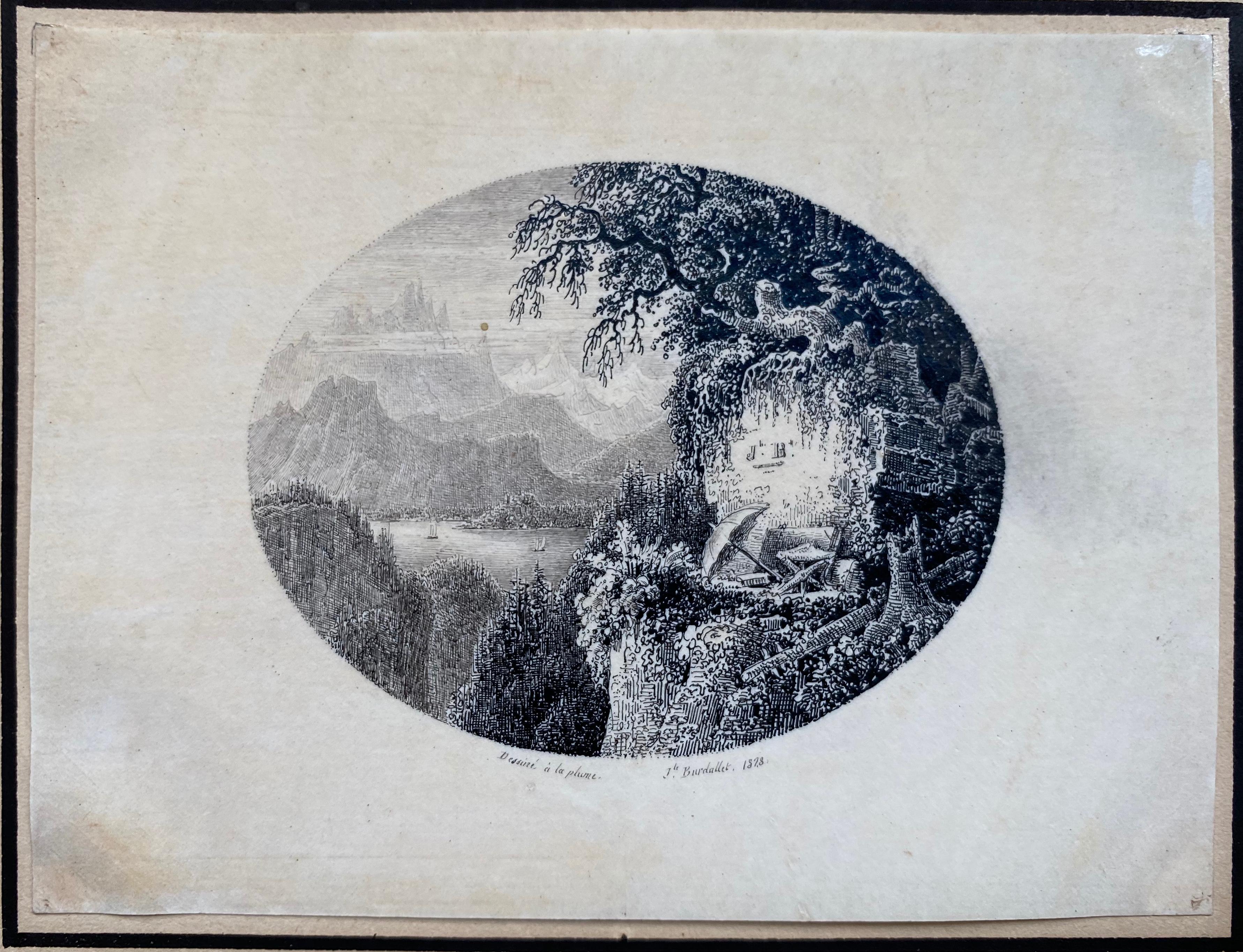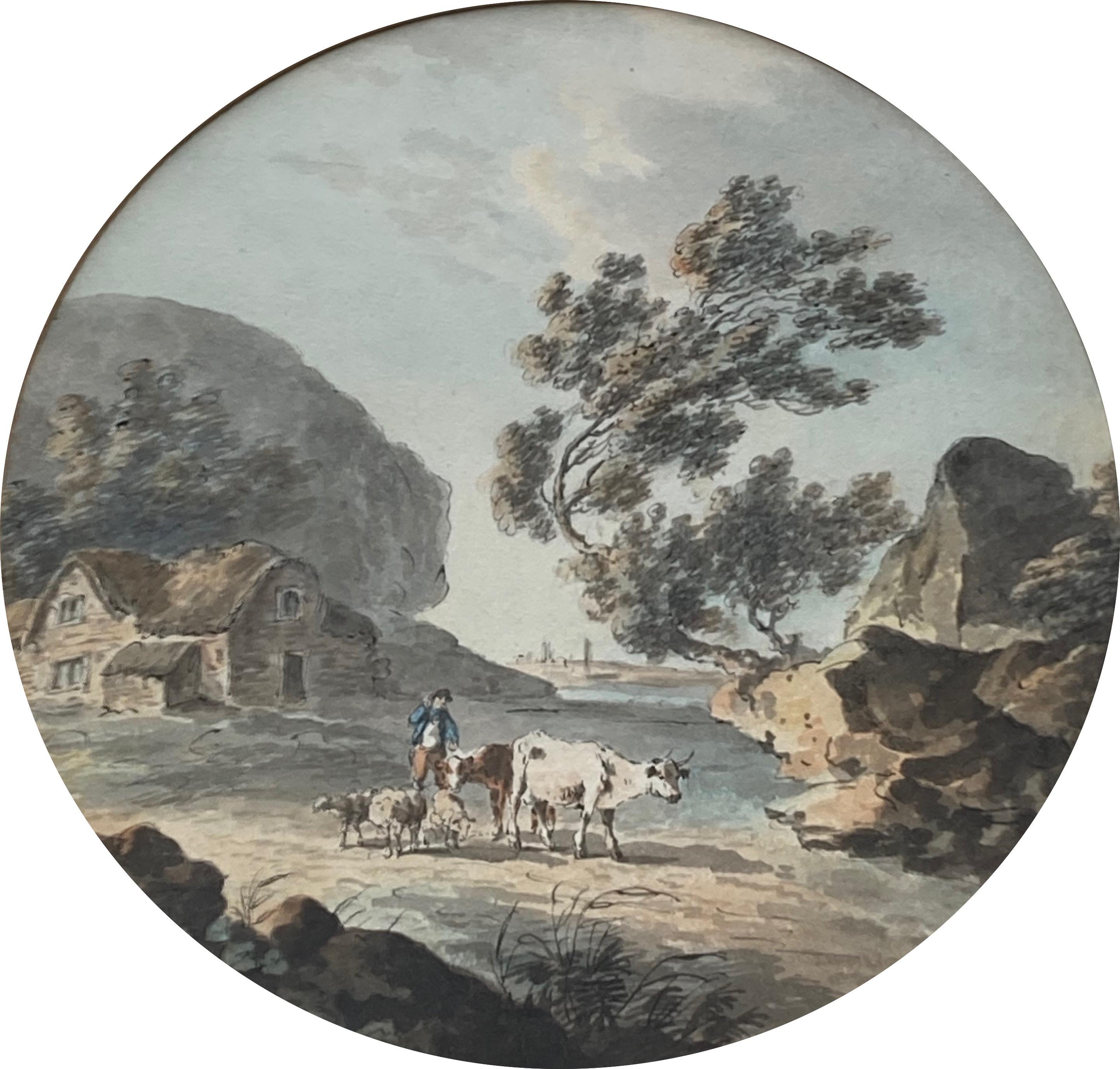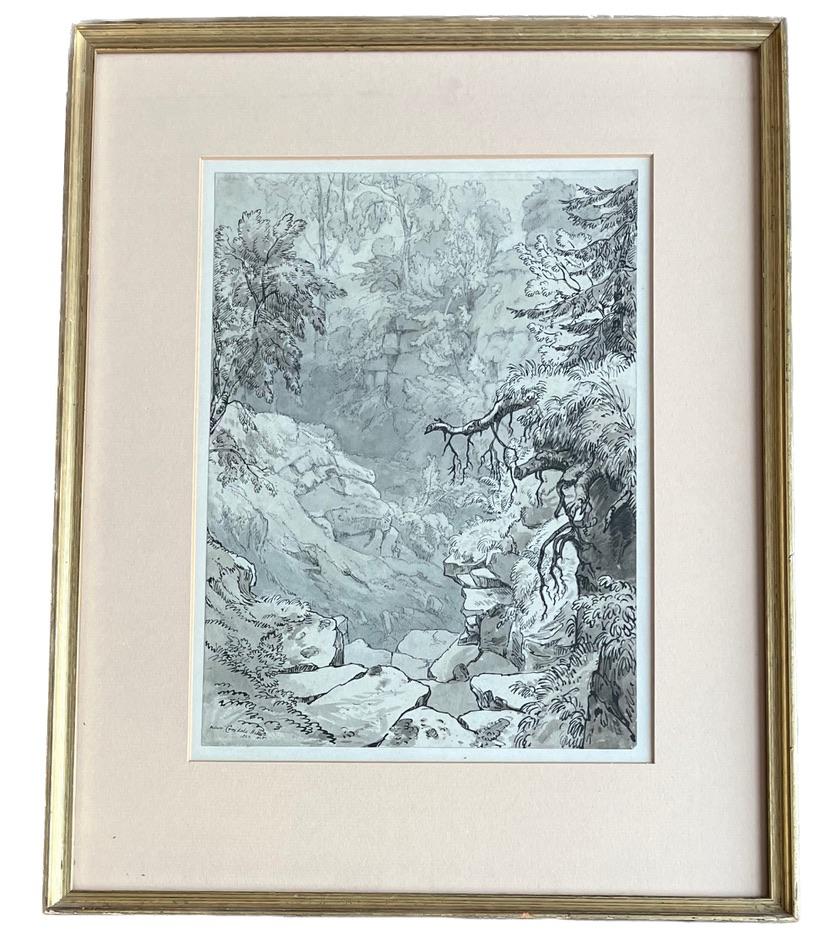Items Similar to A View Near Redhill, 19th Century Pen and Ink Drawing by Samuel Palmer
Want more images or videos?
Request additional images or videos from the seller
1 of 5
Samuel Palmer (b.1805)A View Near Redhill, 19th Century Pen and Ink Drawing by Samuel Palmer
About the Item
Pen and ink on paper, inscribed 'Redhill' and dated 'June 24th 1872' lower left
Image size: 4 x 8 inches (10 x 20 cm)
Mounted and Framed
Provenance
Given to Ernest Pearce by Carlos Peacock, from the collection of Miss Louisa Twining (1820-1911), a pupil of Samuel Palmer.
Carlos noted in his letter accompanying the work to Ernest Pearce that 'Going through my Palmer things for mounting the other day. I found this little sketch dating from the Redhill days. Thought you might like it by way of a Christmas gift'.
Literature
Carlos Peacock, Samuel Palmer , Shoreham and After, published by John Baker 1968, illustrated on page 67.
This delicate pen and ink drawing depicts a view at Redhill, a town in the borough of Reigate within the county of Surrey, England. While Palmer's reputation rests mainly on his Shoreham work some of his later work, such as his sketches from Redhill, have recently received more appreciation.
In 1872 Palmer was living in Redhill, at his last home, The Chantry at Cronks Hill. The Chantry is now Grade II listed due to the Palmer connection and Palmer Close, a cul-de-sac in Redhill (built in the 1960's), was also named in his honour.
This work is an illustration of rural paradise, a vision of the natural world where there is a cosmic harmony between man and his environment. Indeed, Alfred Palmer, the artist's son, wrote 'Had the artist depended for his material solely on the fields, and woods, and hills around him, and had he used that material in a sordid way, he might have given us faithful representations of those he selected, but there would have been inevitable repetition, and he would never have shown us as he has undoubtedly done, the very spirit and quintessence of the loveliest and most poetic pastoral scenery - scenery which we may imagine as that of ancient England, when shepherds piped upon their pipes, and the clouds dropped fatness'.
The Artist
Samuel Palmer was a British landscape painter, etcher and printmaker. He also was a prolific writer and was a key figure in Romanticism in Britain and produced visionary pastoral paintings.
Palmer was born in London, the son of a bookseller and a nurse. Palmer painted churches from around age twelve, and first exhibited Turner-inspired works at the Royal Academy at the age of fourteen. Through John Linnell, he met William Blake in 1824. Blake's influence can be seen in work he produced over the next ten years (generally reckoned to be his greatest). The works were landscapes around Shoreham, near Sevenoaks in the west of Kent. They were among the few who saw the Shoreham paintings as, resulting from attacks by critics in 1825, he opened his early portfolios only to selected friends.
After returning to London in 1835, and using a small legacy to purchase a house in Marylebone, Palmer produced less mystical and more conventional work. Part of his reason in returning to London was to sell his work and earn money from private teaching. He had better health on his return to London, and was by then married to Hannah, daughter of the painter John Linnell who he had known since she was a child, and married when she was nineteen and he was thirty-two. Palmer turned more to watercolour which was gaining popularity in England.
From the early 1860s he gained some measure of critical success for his later landscapes, which had a touch of the early Shoreham work about them – most notable is the etching of The Lonely Tower (1879). He became a full member of the Water Colour Society in 1854, and its annual show gave him a yearly goal to work towards.Palmer's later years were darkened by the death in 1861, at the age of 19, of his elder son Thomas More Palmer – a devastating blow from which he never fully recovered. He lived in various places later in his life, including a small cottage and an unaffordable villa both in Kensington, where he lived at 6 Douro Place, then a cottage at Reigate. But it was only when a small measure of financial security came his way, that was he able to move to Furze Hill House in Redhill, Surrey, from 1862.
Palmer died in Redhill, Surrey, and is buried with his wife in St Mary's, Reigate churchyard.
- Creator:Samuel Palmer (b.1805) (1805 - 1881, British)
- Dimensions:Height: 4 in (10.16 cm)Width: 8 in (20.32 cm)
- More Editions & Sizes:1 of 1Price: $10,729
- Medium:
- Period:
- Condition:
- Gallery Location:London, GB
- Reference Number:1stDibs: LU52412619562
About the Seller
5.0
Vetted Seller
These experienced sellers undergo a comprehensive evaluation by our team of in-house experts.
Established in 2007
1stDibs seller since 2014
63 sales on 1stDibs
Typical response time: 4 hours
- ShippingRetrieving quote...Ships From: London, United Kingdom
- Return PolicyA return for this item may be initiated within 14 days of delivery.
More From This SellerView All
- Ramnagar Fort, India, Company School Late 18th Century Pen and InkLocated in London, GBCompany School 18th Century Ramnagar Fort, India Pen & ink on paper Inscribed and dated 1793 Acid free mount This incredible detailed work would probably have been drawn by an En...Category
Late 18th Century English School Landscape Drawings and Watercolors
MaterialsInk, Pen
- Ancient Oak Trees in Lullingstone Park, Samuel Palmer Watercolour and InkBy Samuel Palmer (b.1805)Located in London, GBWatercolour and pen and ink on paper, inscribed verso Image size: 5 x 4 inches (13 x 10 cm) Framed This drawing most likely depicts a view in Lullingstone Park, near the village of ...Category
Mid-19th Century English School Landscape Drawings and Watercolors
MaterialsInk, Pen, Watercolor
- The Works, Pen and Ink 20th Century Artwork, Female British ArtistLocated in London, GBPen, ink and wash on paper Image size: 8 1/2 x 9 1/2 inches (21.5 x 24 cm) Mounted Mary A Brooks Mary A Brooks was a notable contributor to a vast array of children's publications...Category
20th Century Modern Landscape Drawings and Watercolors
MaterialsPaper, Ink, Pen
- Christmas in the City 20th Century Pastel & Watercolour London SceneLocated in London, GBEnglish School Early 20th Century Pastel, ink and watercolour on paper 4 1/2 x 3 3/4 inches (11.5 x 9.5 cm) Acid free mount and contemporary frameCategory
Early 20th Century Landscape Drawings and Watercolors
MaterialsInk, Pastel, Watercolor
- Service VehiclesBy Reginald ShuffreyLocated in London, GBColoured inks on paper Image size: 18 x 14 inches (45.75 x 35.5 cm) Modern handmade frame Shuffrey was an important pre-war artist who did advertisements and worked for The Motor a...Category
Mid-20th Century Art Deco Landscape Drawings and Watercolors
MaterialsInk
- Return from the Hunt, Pen and Ink 17th Century Artwork, Handmade Gilt FrameLocated in London, GBPen and ink, brown wash, heightened with white bodycolour Image size: 9 x 10 1/2 inches (22.75 x 26.75 cm) Mounted with hand made gilt frame Lingelbach presents a scene from the end...Category
17th Century Landscape Drawings and Watercolors
MaterialsInk, Paper
You May Also Like
- A landscape drawing by Claude Lorrain, with a preliminary sketch on the versoBy Claude LorrainLocated in PARIS, FRThis study presents a typical Roman countryside landscape: an ancient mausoleum in front of which a cart is passing by followed by two peasants. If the technique (a pen drawing on graphite lines, completed with a wash of brown and grey inks) and the signature inevitably evoke the art of Lorrain, we find on the verso of this drawing additional evidences that lead us to consider this unpublished drawing as a work by the master. The motif of the mausoleum has been taken up in pen on the verso in a technique that can be found in several other drawings by Lorrain. There is also a study of three characters, which can be considered as preparatory to Lorrain’s painting entitled The Port of Ostia with the Embarkation of Saint Paula, leading us to claim this attribution with a dating of around 1629. 1. Claude Lorrain or the perfection of classical landscape in Rome in the 17th century Claude Gellée was born in 1600 in Chamagne in Lorraine. Orphaned at the age of twelve, he spent a year with his brother in Freiburg, where the latter was a woodcarver. Claude Gellée then probably arrived in Rome in 1613, where he joined the workshop of Agostino Tassi (1580 - 1644) in 1617. Between 1619 and 1620 he studied for two years in Naples in the workshop of Goffredi Wals (who was himself a former pupil of Tassi). In 1625 he returned to Lorraine for two years where he worked alongside Claude Deruet. He then returned to Rome, a city he never left for the rest of his life (except for short trips to the surrounding countryside). From 1627 to 1650 he lived in Via Margutta. From 1635 onwards he became a renowned painter and commissions started to pour in. Considered during his lifetime as the most accomplished of the classical landscape painters, his reputation never faded. Between 1629 and 1635 Le Lorrain often went to the Roman countryside to draw with his friend Joachim von Sandrart (1606 - 1686). He became a member of the Academy of Saint Luke in 1633, while being closely acquainted with the Bentvueghels, this guild which brought together the young Nordic painters active in Rome. In 1643 he joined the Congregation of the Virtuosi. In 1650 he moved to Via Paolina where he lived until his death. Little is known of his intimate life. He seems to have had a daughter, Agnes, from an ancillary love affair. In 1657/ 1658 she moved in with him. Stricken with gout in 1663, he died in 1682. 2. Description of the drawing; the technique of nature studies Two peasants are walking behind a horse-drawn cart on a road that winds through ancient tombs. While a rectangular tomb with a columned facade can be seen in the distance, the cart passes an important ancient building. It has a circular shape and its partially ruined façade is decorated with columns. The start of a second floor can...Category
1660s Old Masters Landscape Drawings and Watercolors
MaterialsInk, Graphite, Pen
- Pen & Ink Watercolor of HouseLocated in San Francisco, CAC. 20th Century - Original Pen & Ink watercolor of a House. Signed & Dated Lower right corner ( Deon 74' )Category
20th Century Landscape Drawings and Watercolors
MaterialsInk, Watercolor, Pen
- “Untitled”By Joseph Francois BurdalletLocated in Southampton, NYRare and finely detailed miniature pen and black ink drawing by the Swiss artist, Joseph Francois Burdallet on vellum. Inscribed by the artist at lower left, "Dessiné à la plume"; at lower right, "Burdallet, 1828”. Presently unframed. .A series of 8 similar miniature ink drawings...Category
1820s Academic Landscape Drawings and Watercolors
MaterialsInk, Pen, Vellum
- Early English watercolour, Figures and cattle by a riverBy William PayneLocated in Harkstead, GBA delightful composition by this master watercolourist. William Payne (1760-1830) Figures and cattle by a river Watercolour 7¾ inches, circular, unframed 15 x 14½ inches with the fr...Category
Early 19th Century English School Figurative Drawings and Watercolors
MaterialsPaper, Ink, Watercolor, Pen
- Early 19th Century English watercolour of woodland near Croxdale HallLocated in Harkstead, GBA very attractive and meticulously executed view of a rocky landscape within the woods dating to 1823. This would suit a library or study with its muted tones and skifull draughtsmanship. William Nicholson (1781-1844) Near Croxdale Hall Signed with initials and inscribed with title and date 1823 Pen, ink and grey wash 11 x 8 inches, image only 17 x 13 inches without frame The portrait-painter and etcher William Nicholson was born in Ovingham-on-Tyne, Northumberland, on Christmas Day 1781. His family transferred to Newcastle when his father was appointed Headmaster of the city's Grammar School. At an early age, though, Nicholson appears to have moved to Hull where he made his artistic debut, painting miniatures of officers garrisoned there. He was almost entirely self-taught, learning his craft through the close study of artworks in private and public galleries. He subsequently returned to Newcastle where he received many commissions to paint portraits of the old families of Northumberland. In 1808, he began to exhibit at the Royal Academy, continuing to do so until 1822. By 1814, Nicholson, whose mother was a Scot, had moved to Edinburgh where he set up as a miniaturist and painter in oils. Soon, however, he began to specialize in watercolour portraits. Early subjects included the actor Daniel Terry and the poet and novelist James Hogg. In 1818 he began to publish a series of Portraits of Eminent Scotsmen, etched from his own portraits and those of other painters. Besides Scott and Hogg, the subjects included the writers Robert Burns, John Wilson ('Christopher North'), and Lord Jeffrey, the painters Sir Henry Raeburn, the divines Alexander Carlyle and Alexander Cameron, the engineer James Watt, the architect John Playfair, and the song-collector and composer George Thomson...Category
Early 19th Century Academic Landscape Drawings and Watercolors
MaterialsWatercolor, Pen, Ink, Paper
- Veillee Sepulchrale; Verso: Study of two figures in a landscapeBy Eugene BermanLocated in Fairlawn, OHVeillee Sepulchrale Verso: Study of two figures in a landscape Pen and ink on rose colored Canson watermark paper, 1944 Signed in ink with the artist's initials lower center (see photo) Dated 1944 lower center; Titled in ink upper left corner (see photo) Provenance: Swann Galleries, 2010, realized $900. John Popplestone (1928-2013), Akron, OH collector, noted psychologist and author Berman brothers (painters) From Wikipedia, the free encyclopedia Jump to navigationJump to search This article is about the painters. For the American songwriters/producers, see Berman Brothers (producers). Eugene Berman in Italy in the 1960s Eugène Berman (Russian: Евгений Густавович Берман; 4 November 1899, Saint Petersburg, Russia – 14 December 1972, Rome) and his brother Leonid Berman (1896 – 1976[1]) were Russian Neo-romantic painters and theater and opera designers. Contents 1 Early years 2 Later years and death 2.1 Works 3 Legacy 4 See also 5 References Early years Born in Russia, the Bermans fled the Russian revolution in 1918. In Paris the Bermans exhibited at the Galerie Pierre where their work earned them the name "Neo-Romantics" for its melancholy and introspective qualities, having taken inspiration from the Blue Period paintings of Pablo Picasso. Other Neo-Romantic painters were Christian Bérard, Pavel Tchelitchev, Kristians...Category
1940s Surrealist Landscape Drawings and Watercolors
MaterialsInk, Pen
Recently Viewed
View AllMore Ways To Browse
Pen Antique
Small Pipes
Hannah Small
Carlos Villa
England Watercolor 19th
Louis Vuitton Meteor
Rosemary Cove
Rush Band Poster
Andrew Wyeth Books
Louis Vuitton Hope
Louis Vuitton Lyon France
Florian K Lawton
Horseshoe Statue
Looe Landscape Paintings
Sister Sledge
Louis Vuitton Lyon
Louis Vuitton Dream Paris
Black Night Bavaria




